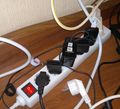In a previous post I've been looking at the pros and cons of my recent switch from Symbian to Android. One of the reasons to go for a dual-device strategy and still keep a Symbian device for taking high quality pictures and for road navigation is that I haven't found an Android device yet that comes close in either of these categories. As far as navigation is concerned here are some more details why:
Note by the way, that I am comparing Google Maps to the Symbian version
of Nokia maps and not the Windows phone version. I'm not familiar with
the Windows phone version of the program so I have no idea how it
compares to the Symbian implementation.
Before listing the cons I'd like to mention one feature I really like about Google Maps which is not implemented as nicely in Nokia Maps on Symbian: Real time traffic situation overview that is updated every couple of minutes. Especially for my daily commute I am now checking regularly while on the road if there's a traffic jam at two neuralgic points and take an alternate route before getting stuck. It works perfectly!
On the other hand, there are quite a number of features that are much better implemented in Nokia Maps for Symbian:
Offline Routing Capability
Let's bring up the biggest issue first. I travel a lot to foreign countries and roaming charges for data are usually highly prohibitive. In other words there is no way I can use Google maps abroad as it requires a data connection to download maps for car navigation or using it for guidance while on foot. For Nokia Maps on my Symbian device I have maps of all the countries I travel to on the device. Sure, that takes a couple of gigabytes of flash memory but there's more than enough in today's devices.
Routing
The routing algorithm in Google Maps is a bit strange and has led me several times through cities instead of using the bypasses which might not be as direct but much faster due to no traffic lights and city speed limits. Also in my home city, when I used navigation just to see what it would do has let me to the destination via roads which were neither direct nor optimal. Doing the same with Nokia maps has found the direct and best way. So still a bit of work to do for the Google team here.
No Speed Indication
Another thing which I like very much when being guided by a navigation system is to see the speed as calculated by the GPS receiver, which is much more accurate than my car's built in speedometer and also closer to other information such as routing and and speed limit data. Unfortunately Google Maps in navigation mode doesn't show the current speed.
No Speed Limit Indication
What I really have come to like in Nokia maps is that it shows the current speed limit next to my current speed and starts changing the background color of the speed indication to red and also gives an audible warning if desired. From my experience that maximum speed limit indication is very accurate. In Germany, where speed limits on the freeway changes every few kilometers for some reason or another it's easy to miss a speed limit sign just before a speed camera… This feature has saved me tons of money already and relieves me of being constantly on the lookout for speed limit signs. Unfortunately that's not available in Google maps yet and a real killer feature for me!
No Lane Assistant
Next in the list of missing features is the lane assistant. Nokia Maps and most other navigation systems that have been around for some time indicate to the driver in cities and at freeway exits which lanes to to take as this can sometimes be confusing. While not a must have feature for me it helps orientation in crucial moments.
No Distance Indication
Google likes to show the approximate time to the destination. That's nice but I'm an engineer, I like the hard facts, I want to know the remaining kilometers or miles. In Nokia Maps the display can be switched between the two.
Navigation in Tunnels
An important feature when driving through tunnels is that the navigation system keeps updating the approximate position even when no GPS signals is available as otherwise one easily misses exits that come right after the tunnel. A couple of years ago Nokia Maps didn't have that functionality and I was really happy when they added it. Unfortunately, Google Maps doesn't have this feature so far. Which means missing exits…
Horrible Pronunciation of Street Names
I usually disable voice guidance and just use the map. However, there are some exceptions during which I use voice Guidance. I use an Android device with the language set to English and Google maps assumes I want to hear the direction announcements in English, too. While this is true in general it unfortunately also announces the street names in English no matter in which country I am. To a native speaker, German or French street names with English pronunciation just hurts. Sorry Google, I'd really like to be able to switch that off if the maps application can't pronounce street names correctly and just be audibly informed which direction to go and when to make a turn. No pronunciation torture, please!
There we go. While some of the reasons are not really a show stopper, the missing speed indications in combination with the sub-optimal rooting and missing country-wide offline capability will make me stick with my dual device strategy for the foreseeable future.
